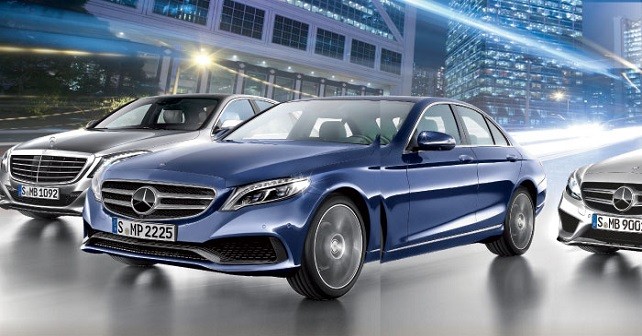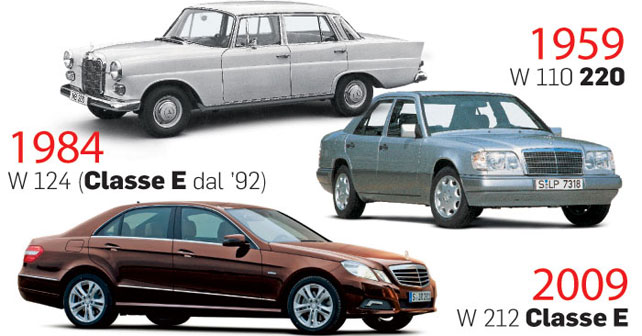The S and C are brand new. So, the Mercedes E Class is next in line for a new generation model. The primary objective, of course, will be to ensure that the three-pointed star is back at the top of the sales charts once again.
The Mercedes E Class represents the heart of the Mercedes-Benz range. This was declared in 2009, at the launch of fourth generation of the model, by Klaus Maier, Head of Sales & Marketing for the firm – who is now CEO of the Chinese operations. Since then much has changed – from the markets in which Mercs are manufactured, to the ones that generate the most revenue, to the art of stimulating old and new customers alike, and also when and how to renew the range in a environment that’s growing increasingly competitive.
In this world, which is fast becoming a global village, the job of preserving and reaffirming the brand values of the three-pointed star is entrusted to the medium-to-large sized sedan. As already mentioned, the competition is getting more-and-more fierce. In 2013, there were 242,562 E Classes sold globally (7.6% more than the year before) – that, however, puts Mercedes third in its category on the sales charts, after the BMW Series 5 and the Audi A6. And this is despite a substantial facelift of the car last year, which earned it the tag – in the words of big boss Dieter Zetsche – ‘The best E Class ever.’ With an investment twice that of a usual mid-life facelift, Mercedes has aligned the styling to the design language of the S and C Class – ensuring that it remains fresh, with increased equipment levels. In fact, Mercedes has added eleven new (or upgraded) driving assistance systems. The range of engines has also been improved, with the arrival of the more efficient BlueDirect four-cylinder engines.
The aim for the fifth generation E Class, if we count from when it was named as such – which was back in 1992, although the origins of the model start from the 1950’s – is to reposition the brand back to the height of the luxury car market, from where it was ousted by BMW in 2005. By 2016, the next-gen E Class will come forth with a package that reflects its excellent past and moves it into the future with cutting edge style, equipment, and engines.
As far as engines are concerned, it’s still quite early to hazard a guess, but if you discount the extreme ends of the scale – the AMG’s at one end, and the hybrids at the other, which will include two plug-ins that’ll be developed in collaboration with Tesla – it’s safe to assume that the entire range of power-plants will feature reduced fuel consumption and emissions. What is likely is that Mercedes will revert to using in-line six cylinder units again – a configuration that was abandoned by the Star in mid-90’s. And while the new E Class alone wouldn’t justify the investment in developing a new range of engines, this new inline configuration will be modular and subsequently used in a number of models in varying engine sizes going forward.
Classic or Sports
As far as the styling goes, the next E Class chooses the path of evolution – as the Star has always chosen, rather than radical change. Thus, the innovations stretched to woo young and dynamic buyers will be tempered by the needs of more conservative clients. In this respect, you can expect two different styling options for the front – one with the classic radiator that has the star positioned on the bonnet, and another more sporty style with the star in the middle of the grille. A small revolution, however, occurred with the facelift of last year. Ditched were the four headlights, introduced in 1995, and which have since been a distinctive sign of the E class. The lights are now collected under a single glass frame, but with a double horizontal line that separates the low beams from the LED daytime running lights. In future, though, this styling trait will most likely be further toned down. As for girth, the next E could lose a small portion of its weight thanks to the use of lightweight materials. The next generation will also be obligated to aim for the maximum in terms of technology – the highlight of which will likely be a semi-automatic guidance system that will provide limited scope for a driver to indulge in some distractions while on the highway.
Reinvent or perish
The latest generation of the C Class, and the technological excellence of the S Class flagship, point to the likely shape and substance of the future E Class. After a substantial restyling last year, Mercedes is preparing for the fifth generation of the E Class. Of course, the next gen E will continue to offer two choices – a sports version (shown here) and the classic design with the star located on the bonnet
New Rear Design
The rear will also be updated – the lines are softer and the tail lights are thinner. The sides, as well, come out cleaner
A dynasty that has come a long way
Initally it was the 220
The E Class name appeared only in 1992, when the W 124 model (1984-95) was at the end of its life. But the origins of the E Class arose right from the 170 V of 1947. 1959 was the debut year of the 220b (or W 110 as per the internal codename). From one generation to the next, the model evolved, until the W 124. It was succeeded by the W 210 in 1996, W 211 in 2002, and in 2009 by the current generation, which was face-lifted early last year.
© Riproduzione riservata






















Write your Comment